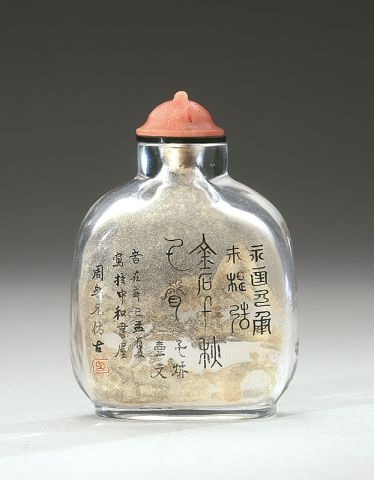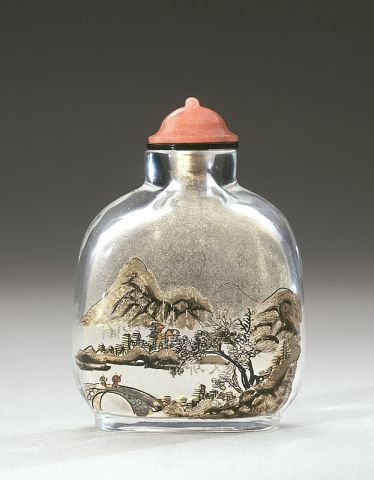

Bottle ID: 00687
ZHOU LEYUAN, FIGURES IN MOUNTAINOUS LANDSCAPE & INSCRIPTIONS
Date: July 26th - August 25th, 1881
Height: 50 mm
Glass, ink, gold paint and watercolors, of flattened square form with rounded shoulders, painted on the inside with on one side, two figures crossing a bridge over a river in a mountainous landscape; the reverse with four sets of inscriptions in differing scripts reading:
"First year of the Yongjian era."
"Made at Zhushi."
"Metal and Stone, sounds that last thousands of autumns."
"Thousand Autumns Pot Inscription."
"First month of summer in the year xinsi
Written at the Studio of Equanimity and Harmony."
"Zhou Leyuan, emulating an ancient inscription."
With one seal Yin.
Similar Examples:
Crane Collection no. 902.
Moss, Hugh M. Snuff Bottles of China, 1971, pp. 146-147, no. 407.
Sotheby's, London, October 28, 1970, lot 248.
Sotheby's, Hong Kong, November 16, 1989, lots 150 and 160, The Kaynes-Klitz Collection, Part I.
Moss, Hugh, Victor Graham and Ka Bo Tsang. A Treasury of Chinese Snuff Bottles - The Mary and George Bloch Collection, 2000, Vol. 4, Part 1, pp. 260-261.
Provenance:
Asian Art Studio
Bonhams & Butterfields
Exhibited:
Annual Convention ICSBS Toronto, October 2007
The Crane Collection now houses the two earliest known inside painted bottles by Zhou Leyuan. The first example is Crane no. 902 which is signed 'Leyuan Zhou Kuishan', the personal name of Zhou Leyuan and one which he quickly changed.
The second is the bottle shown here, which is painted in a completely different style and uses ink and gold, rather than the more usual ink and watercolors. It is also unique in that while it is signed by Zhou Leyuan, a previously unrecorded studio name is given - the 'Studio of Equanimity and Harmony'. It is dated to the first month of summer which translates to July 26th - August 25th, and to 1881, almost exactly two years after his earliest known bottle.
Zhou generally used the 'Studio of Lotus Root Fragrance' throughout his career. It was previously thought that the exception to this was in 1891 when for three months in the summer, Zhou used the 'Studio of Thirty-six Documents'. One suggestion for this change was that Zhou left Beijing at this time and worked elsewhere - not uncommon for artists in China at the time. It is not clear, with the Crane bottle as the only extant example, whether the 'Studio of Equanimity and Harmony' was also a temporary summer sojourn early in Zhou's career.
Although the two Crane bottles differ in style, they are united in Zhou's use of differing calligraphic scripts. In both bottles he attempts, with success, different scripts, although the earlier bottle (no. 902) is, in some senses, more sophisticated than this example, both in the use of crystal as a material rather than glass and in sheer poetic elegance. This again emphasizes the point made in the commentary of Crane no. 902 that these bottles could not have been Zhou's first works.
There is a second bottle dated to 1881 which was sold in Sotheby's London in 1970. This bottle, painted with a landscape, is signed 'Leyuan' with the name 'Shi Gedong' which may be an art name. Moss in 'Snuff Bottles of China' illustrates another bottle painted with a landscape in ink and gold which is very similar in style to this Crane bottle. It is dated to the following year of 1882 and is signed 'Shi Gedong'. The Crane bottle connects these two bottles, with the three of them leading to a conclusion that firstly, 'Shi Gedong' was an art name of Zhou Leyuan and secondly, that one of his earliest studio names was the 'Studio of Equanimity and Harmony'.
Zhushi, refered to by Zhou, is the name of a district in Yunnan, famous during the Eastern Han era for the fabrication of bronze vessels. The "First year of the Yongjian era" is equivalent to 126 C.E.
< Back to full list
 English
English 中文
中文